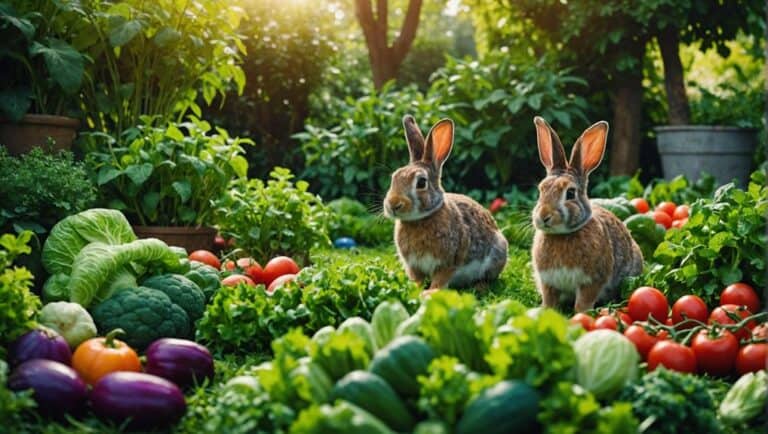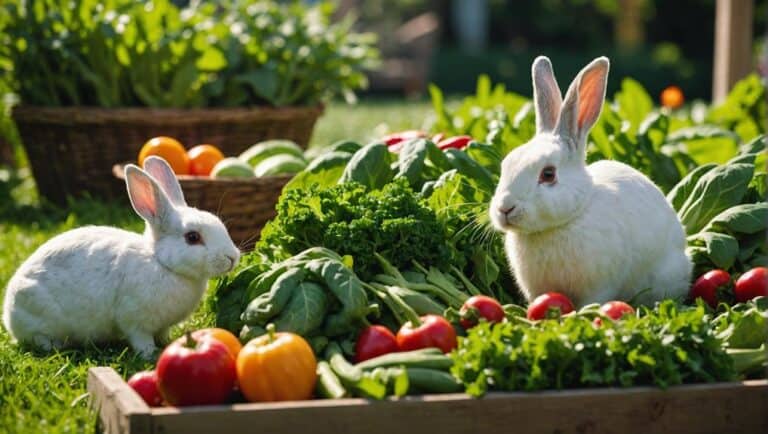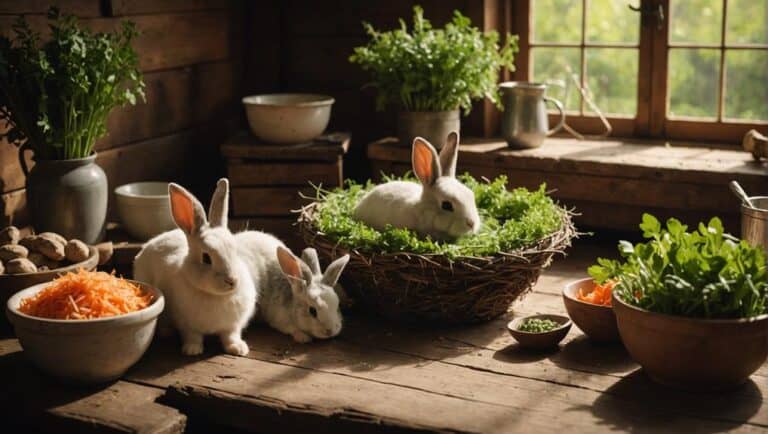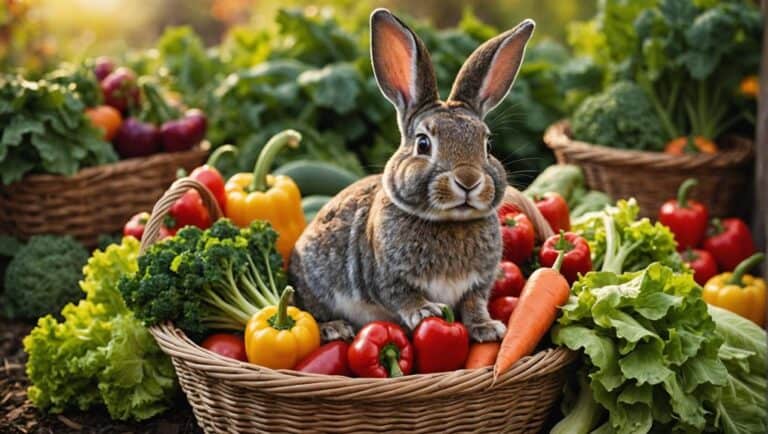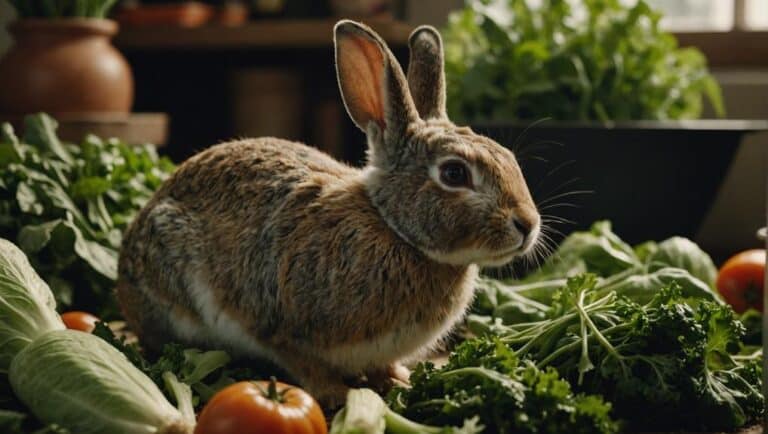Just like the fabled tortoise, your rabbit's health depends on steady, informed choices rather than hasty decisions. When selecting the right pellet food, it's crucial to take into account factors like fiber content and ingredient quality, as these can greatly influence your pet's well-being. You might be surprised by how many options are out there, but not all are created equal. What should you look for in a pellet, and how can you guarantee it meets your rabbit's specific needs? Understanding these nuances is key to fostering a healthy diet for your furry companion.
Contents
- 1 Identifying Healthy Pellets
- 2 Nutritional Composition Standards
- 3 Age-Specific Feeding Guidelines
- 4 Alternatives to Pellet Diets
- 5 Evaluating Pellet Brands
- 6 Transitioning to New Pellets
- 7 Understanding Dietary Health Implications
- 8 Community Insights and Resources
- 9 Recommended Rabbit Food Products
- 10 Final Thoughts
Identifying Healthy Pellets
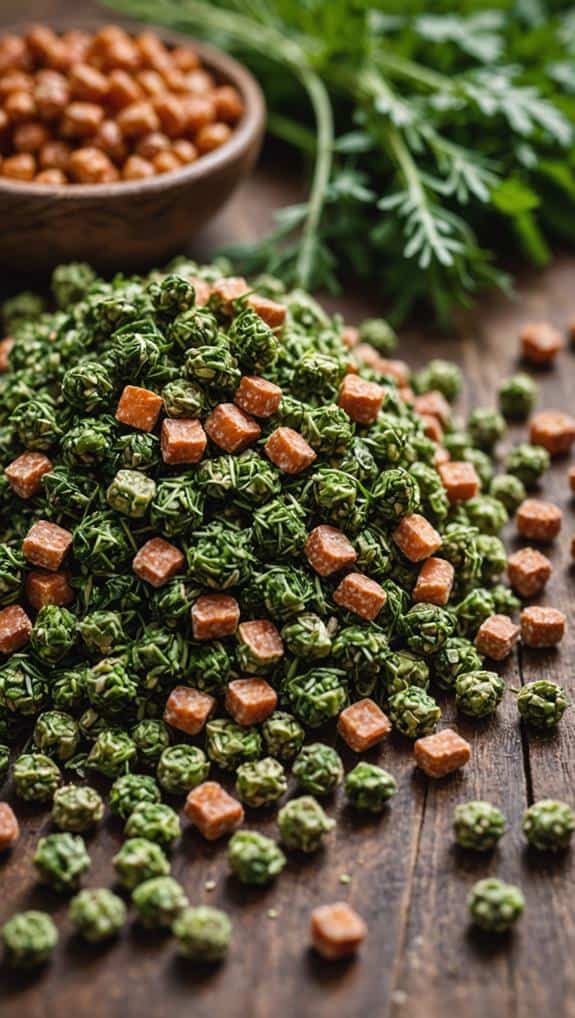
When selecting rabbit pellets, it's important to focus on identifying healthy options that support your pet's digestive health. A quality rabbit diet should mainly include high-fiber ingredients, with at least 22% crude fiber to guarantee proper digestion. This high-fiber content plays a significant role in maintaining a healthy weight and preventing obesity-related issues, making it necessary to choose pellets that promote digestive wellness a balanced bunny diet.
Look for pellets that list Timothy hay or other grass hays as the first ingredient; these serve as the foundation for a balanced diet. Avoid rabbit pellets containing dried fruits, seeds, or colorful additives, as these can promote selective eating habits that might lead to nutritional imbalances.
The protein content in quality pellets shouldn't exceed 14%, and calcium should be around 1.0% to help prevent obesity while supporting bone health. To confirm you're meeting your rabbit's nutritional needs, regularly check the ingredient list and expiration dates on pellet packaging.
Freshness is essential for maintaining the nutritional integrity of the food. By diligently selecting high-quality rabbit pellets, you're setting the stage for a healthy diet that supports your pet's overall well-being and longevity. Choosing the right pellets is a crucial step in making sure your rabbit thrives and enjoys a healthy, fulfilling life.
Nutritional Composition Standards
Understanding the nutritional composition standards for rabbit pellets is essential for ensuring your pet's health and well-being. A well-balanced diet that includes high-fiber pellets can greatly contribute to a balanced diet for your bunny, supporting their overall liveliness.
When selecting pellets fed to your rabbit, focus on their nutritional value, particularly the fiber content, which should be at least 22% to support healthy digestive systems and prevent gastrointestinal issues.
Protein levels in the pellets shouldn't exceed 14%, as excessive protein can lead to obesity and related health complications. Additionally, the fat content should remain around 1%, which helps maintain overall health while avoiding excess calorie intake.
Calcium is another critical factor; aim for approximately 1.0% in the pellets to promote bone health and prevent kidney problems. Be cautious with alfalfa-based pellets as they're higher in calories and lower in fiber, making them more suitable for young rabbits rather than adults.
Age-Specific Feeding Guidelines
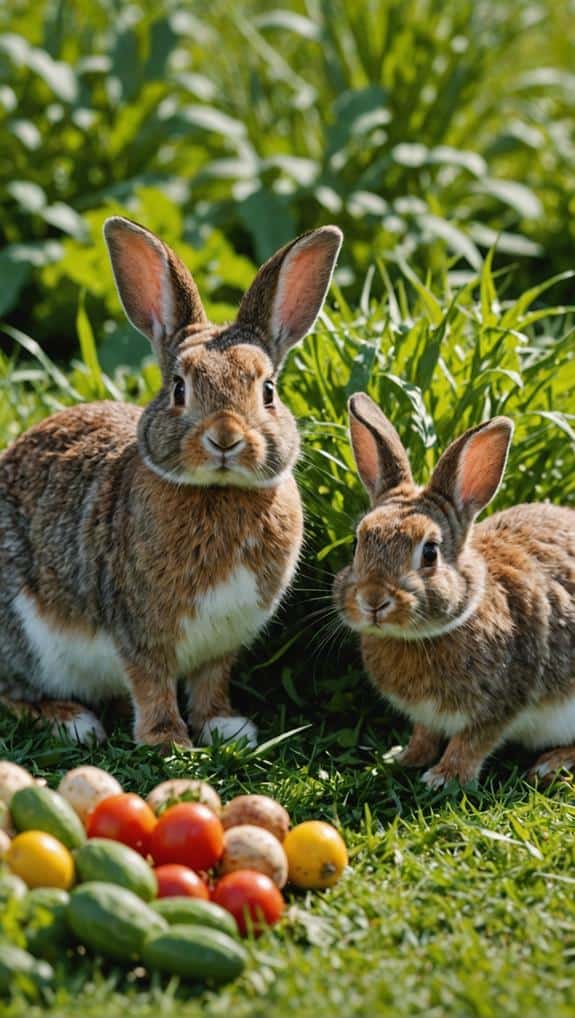
Different life stages of rabbits require specific feeding strategies to meet their nutritional needs effectively. For baby rabbits under one year, you should provide unlimited access to pellets, as they need ample nutrition to support growth and development. It's vital to guarantee that these pellets are high in fiber, as this will help maintain their digestive health and overall well-being, especially during this rapid growth phase.
high-fiber diets are critical. As they reach maturity around 6-7 months, begin shifting them to adult pellets with a focus on high-fiber options to maintain digestive health.
Adult rabbits typically require a portion of 1/4 to 1/2 cup of pellets per 6 pounds of body weight daily. This approach prevents obesity while providing a balanced diet. It's important to monitor their intake since excessive consumption can lead to reduced hay intake, which is essential for digestion and dental care.
Pregnant or nursing rabbits have unique nutritional requirements and should receive specially formulated pellets designed for breeders. This guarantees their health and supports the growth of their young.
Alternatives to Pellet Diets
If you're considering alternatives to pellets for your rabbit's diet, fresh vegetables can provide essential nutrients.
A diet rich in hay as a primary source, supplemented with leafy greens, can promote better health and prevent obesity.
However, it's important to shift gradually and monitor their nutritional intake to guarantee all dietary needs are met.
Nutritional Vegetable Options
Rabbits often thrive on a diet rich in fresh vegetables, which can effectively replace pellets while providing essential nutrients. By introducing a variety of vegetables, you can guarantee your rabbit receives essential vitamins without the excess calories found in pellets.
Leafy greens should comprise a significant portion of their intake. Aim for 1-2 cups of these daily for rabbits under 6 pounds.
Consider including the following vegetables in your rabbit's diet:
- Romaine lettuce: A hydrating leafy green packed with nutrients.
- Kale: High in calcium and vitamins A and C, but should be fed in moderation.
- Cilantro: A flavorful herb that supports health and adds variety.
- Carrots: Serve as an occasional treat due to their higher sugar content.
- Bell peppers: A colorful addition, rich in vitamins but also treat-worthy.
Introduce new vegetables gradually to allow your rabbit's gut flora to adjust. This careful approach helps prevent digestive upset while guaranteeing a nutritious and balanced diet.
Hay as Primary Source
Hay serves as the cornerstone of a rabbit's diet, offering essential fiber that promotes healthy digestion and gut function.
You should prioritize hay as the primary source of nutrition for your rabbit, ensuring it receives at least 22% fiber to maintain ideal gut health.
Timothy hay is particularly well-suited for adult rabbits, providing a low-protein, high-fiber option that supports their dietary needs effectively.
In contrast, alfalfa hay, which is richer in calories and protein, is better reserved for young bunnies.
Supplementing With Fresh Greens
Supplementing your rabbit's diet with fresh greens can greatly enhance their nutritional intake while helping to manage calorie consumption. Incorporating a variety of leafy vegetables can replace a significant portion of a pelleted rabbit diet, providing essential nutrients necessary for their health and well-being.
Aim for about 2 cups of veggies per 6 pounds of rabbit weight daily.
Here are some ideal greens to take into account:
- Romaine lettuce
- Cilantro
- Parsley
- Kale
- Basil
Offering these greens not only boosts nutrition but also keeps your rabbit engaged, reducing the risk of boredom-related destructive behaviors.
It's vital to introduce new greens gradually to avoid digestive upset. Always wash vegetables thoroughly to remove any pesticides or contaminants.
While moving to a fresh greens-based diet, make certain to still provide pellets in moderation. This guarantees that your rabbit receives a balanced nutrient profile without the over-reliance on processed foods.
Evaluating Pellet Brands
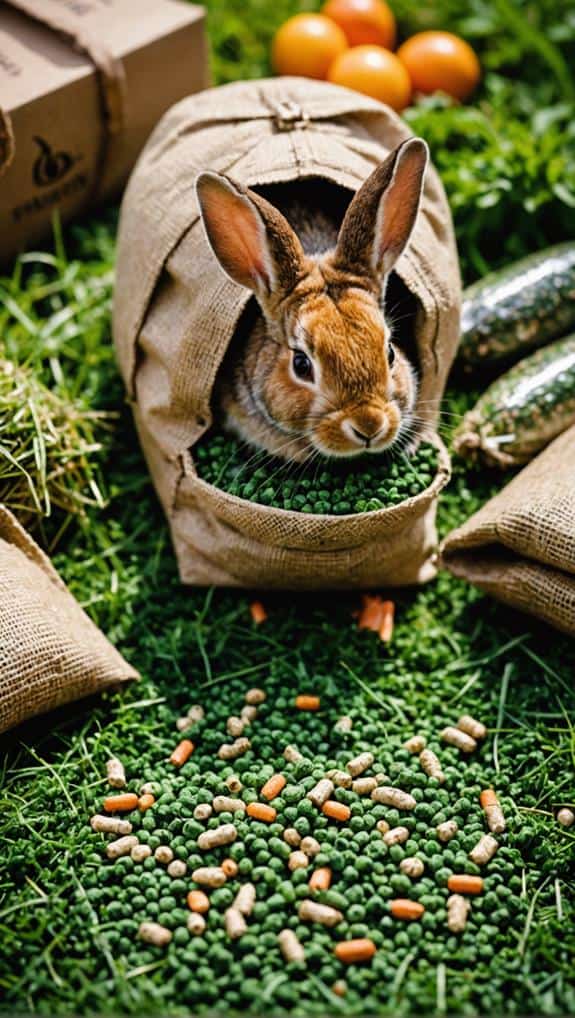
Selecting the right pellet food for your rabbit requires careful review of various brands to confirm ideal nutrition. When evaluating options, consider ingredients, fiber content, and the nutritional balance of vitamins and minerals. It’s essential to pay attention to rabbit pellet food quality factors, as they significantly impact your pet’s health and well-being. Additionally, look for products that are hay-based rather than grain-based, as this aligns more closely with a rabbit’s natural diet.
Start by prioritizing pellet brands that list timothy hay as the first ingredient. This guarantees high fiber content, which is vital for your rabbit's digestive health.
Look for pellets that provide at least 22% crude fiber while keeping protein levels under 14%. This balance helps prevent obesity and promotes overall health.
It's important to avoid brands with fillers, dyes, and seeds, as these can lead to selective eating habits and potential health issues, such as obesity and gastrointestinal blockages.
When evaluating brands, examine the packaging for freshness indicators and expiration dates. This confirms that you're providing your rabbit with the most nutritious options available.
Transitioning to New Pellets
When shifting to new pellets, start by gradually introducing them, mixing 25% new pellets with 75% old ones for the first week.
Monitor your rabbit's stool and behavior closely, adjusting the ratio if you notice any digestive issues.
Always guarantee a consistent supply of hay to support digestion and maintain fiber intake during the switch.
Gradual Introduction Process
Shifting to new pellets is an essential process that requires careful attention to your rabbit's dietary needs. A gradual introduction helps your rabbit's digestive system adjust without causing distress.
Start by mixing 75% of the old pellets with 25% of the new pellets, and follow these steps:
- Increase the proportion of new pellets by 10-25% every few days.
- Monitor your rabbit closely for any signs of digestive upset, like changes in appetite or diarrhea.
- Aim to complete the changeover over 7 to 10 days to guarantee comfort with the new diet.
- Always have fresh hay available, as it aids digestion and maintains gut health.
- Adjust the pace of the changeover based on your rabbit's reactions; a slower approach may be necessary if any issues arise.
Monitoring Digestive Reactions
During the shift to new pellets, closely monitoring your rabbit's digestive reactions is essential for ensuring their health and comfort. Start by gradually mixing the new pellets with the old ones over a period of 7-10 days. This approach minimizes digestive upset and allows your rabbit time to adjust.
Pay attention to your rabbit's stool; healthy droppings should be round and well-formed. Diarrhea or mushy stools can indicate intolerance or a dietary imbalance, signaling that the new pellets mightn't be suitable.
Additionally, observe your rabbit's overall behavior and appetite during this change. A decrease in appetite or any signs of discomfort may be a warning sign that necessitates reconsidering the new pellets you're offering. If your rabbit seems hesitant to eat, incorporating more leafy greens can stimulate their appetite and encourage them to try the new food.
If you notice gastrointestinal distress, such as your rabbit not eating or pooping for 12-24 hours, consult a veterinarian immediately. Prompt action is vital for maintaining your rabbit's digestive health and overall well-being during this important change.
Adjusting Pellet Portions
After monitoring your rabbit's digestive reactions, it's time to adjust the portions of their pellets. Shifting to new pellets requires a careful approach to maintain your pet rabbit's health and well-being.
Start by mixing 25% of the new pellets with 75% of the old ones for the first few days. This minimizes digestive upset while you make the switch.
Follow this gradual plan:
- Day 1-3: 25% new pellets, 75% old pellets
- Day 4-6: 50% new pellets, 50% old pellets
- Day 7-9: 75% new pellets, 25% old pellets
- Day 10: 100% new pellets
Keep a close eye on your rabbit's behavior and digestive health during the shift. If you notice any gastrointestinal distress, slow the process down.
It's also important to provide unlimited access to hay throughout this period, as it promotes gut health and supplies essential fiber.
After completing the shift, maintain regular feeding portions of about 1/3 to 1/2 cup of good quality pellets per day. This balance guarantees your rabbit receives the right calories and nutrients to stay healthy.
Understanding Dietary Health Implications
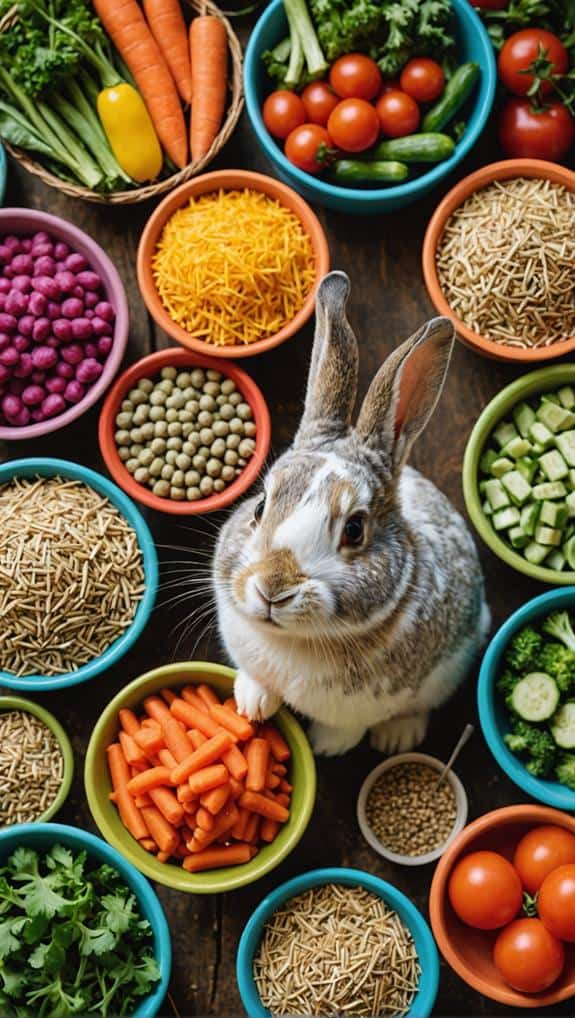
Understanding the dietary health implications of pellet food for rabbits is vital for maintaining their well-being. A balanced diet rich in high-fiber pellets helps prevent gastrointestinal issues like stasis, as rabbits require at least 22% crude fiber for ideal digestive health.
However, relying too heavily on pellets can lead to obesity and related health problems, so it's important to limit pellets to about 5% of your rabbit's daily intake.
When selecting the best rabbit pellets, avoid products with fillers, dyes, or seeds that can harm overall health and encourage selective eating. Assess pellet quality by examining the ingredient list; high-fiber hays like Timothy or alfalfa should be the first ingredients to guarantee adequate nutrition.
Nutritional imbalances from poor pellet choices can lead to severe health issues such as dental disease and kidney problems, making regular vet consultations important.
Incorporating these dietary health considerations into your rabbit care routine won't only promote better health but also enhance your pet's quality of life. By prioritizing the right pellets, you're investing in your rabbit's long-term well-being.
Community Insights and Resources
Community insights play an essential role in traversing the complexities of selecting the right pellet food for rabbits. Engaging with fellow rabbit enthusiasts can offer you valuable advice and support, helping you make informed decisions.
Community forums are treasure troves of shared experiences, where members frequently discuss specific brands and their impact on rabbit health.
Here are some key resources and tips to take into account:
- Join online rabbit care groups to stay updated on the latest pellet products and dietary trends.
- Visit local family-owned pet shops, often recommended for their quality rabbit foods and personalized service.
- Compare nutritional labels across brands to verify your rabbit receives a balanced diet.
- Consult guidelines from the House Rabbit Society, which provide reliable nutritional advice and feeding best practices.
- Participate in discussions about rabbit health to gain insights into the effectiveness of various pellet foods.
Recommended Rabbit Food Products
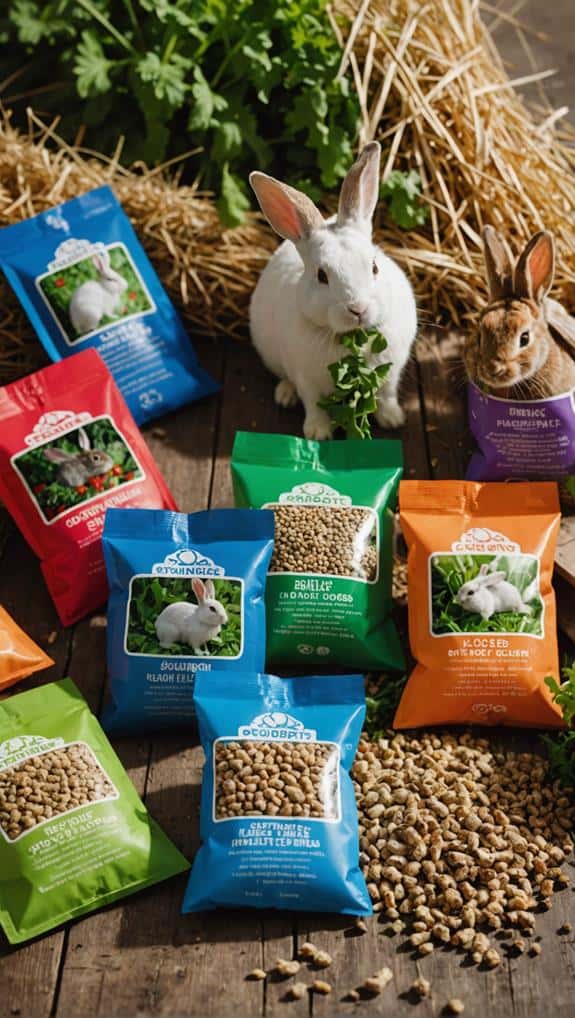
Selecting the right pellet food for your rabbit can greatly impact their overall health and well-being. Among the top choices is Oxbow Adult Rabbit Food, which is specifically formulated to provide balanced nutrition for adult rabbits. Its controlled protein content helps prevent obesity while supporting ideal health.
Another excellent option is Oxbow Garden Select, highly regarded for its high fiber content and natural ingredients, catering to a rabbit's dietary needs.
If you're looking for variety, Small Pet Select Rabbit offers a selection of high-quality ingredients with significant fiber that promotes healthy digestion, making it a favorite among rabbit owners.
For those with rabbits in various life stages, Mazuri Rabbit Food is a trusted choice, providing good protein levels that contribute to overall well-being.
Finally, if you're on a budget, Kaytee Forti-Diet serves as an economical yet nutritionally adequate option, delivering essential nutrients without breaking the bank.
Choosing any of these recommended products guarantees your rabbit might thrive, as each option is designed to meet their specific nutritional requirements.
Your commitment to selecting the right food will truly enhance your rabbit's quality of life.
Final Thoughts
To summarize, selecting the right pellet food for your rabbit is essential for their health. Prioritize high-fiber options with Timothy hay as the main ingredient, and steer clear of additives that can disrupt their diet. Remember, a balanced diet is like a well-tuned engine; it keeps your bunny running smoothly. Stay informed about nutritional standards and consider your rabbit's age when choosing pellets. By doing so, you'll guarantee your furry friend thrives and hops happily through life!

